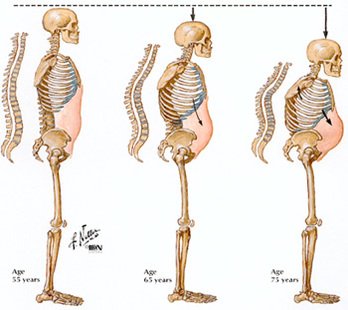Osteoporosis and Pilates
I’ve done several Pilates trainings on working safely with clients with osteoporosis, most recently with PT and Pilates Instructor Zeina Grifoni, the founder of Synergy Pilates, and given how prevalent it is wanted to share some information about the condition and ways we can work to maintain and build bone safely.
Osteoporosis means “porous bone” and is a condition where the density of the bone decreases, especially in the spine, hips and wrists. What’s most challenging about this condition is that people with Osteoporosis don’t experience any pain until a first fracture, and then the likelihood of subsequent fractures increases dramatically. The goal is to prevent that first fracture! Osteoporosis is also incredibly widespread. “30% of all post menopausal women have osteoporosis and 1 in 5 men are at risk of an osteoporotic fracture. After a first fracture there is an 86% chance of a second fracture.”
Because there are no other indications, bone density testing is the only way to diagnose Osteoporosis. The National Osteoporosis Foundation recommends testing for:
Women 65 and over
Men 70 or older
Women/Men who break a bone after age 50
Women of menopausal age with risk factors
Postmenopausal women under the age of 65 with risk factors
Men 50-69 with risk factors
There are a range of risk factors, including age, family history, sex (women are more likely then men to get Osteoporosis), race (White and Asian women are at higher risk), size of body frame. Smaller-framed people are at higher risk. There are also a range of other risk factors – dietary, medications, and medical conditions that put a person at higher risk. To read more see Risk Factors (Mayo Clinic).
As a Pilates instructor my goal is to support bone building (especially around the thoracic spine, hip and wrists) through muscle strengthening, balance training, and, critically, to work in positions that don’t put clients at risk for fractures. This means NO Loaded Spinal Flexion (forward bends in standing, rolling up into an abdominal curl, rolling like a ball, any position that rounds head towards feet or takes legs over the head, e.g. shoulder stands). If you look at the image below you see that Osteoporosis tends to cause us to round forward (into increased kyphosis) bringing the front of the vertebrae closer together.
Loaded spinal flexion increases that rounding, putting pressure on fragile bones, which is why the majority of osteoporatic spinal fractures happen in the thoracic spine. It’s also clear from this image that extension exercises are one of the best things we can do to support not only postural changes to prevent fractures, but bone building as well. Swans, Cat Stretch, upper back lifts, and swimming are all great extension exercises.
For those of you who do other forms of exercise, yoga, weightlifting consider any exercises that ask you to bend forward and ask your instructors for modifications that allow you to stay in neutral spine (the natural curves of the spine).
If you have any concerns, talk to your doctor about a bone density exam. For more information you can also visit the Bone Health and Osteoporosis Foundation.


